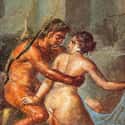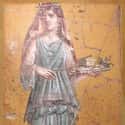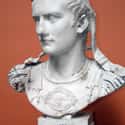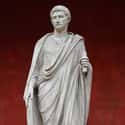-
(#7) MYTH: Ancient Rome Was An Orgy-Crazed Society
Reality: According to classical scholar Alastair Blanshard, intimate encounters invovling multiple partners were uncommon in ancient Rome. There are few firsthand accounts of such activities in ancient Rome, despite their constant presence in film and television depictions of the Roman Empire.
Why The Myth: It's believed that Christian writers used satirical writing by Romans to reframe the pagan society as a community marked by depravity, gluttony and lechery. Depicitons of outrageous bacchanals emphasized the lust and decadence of the ancient period in order to denounce it.
-
(#10) MYTH: Women Had A Lot Of Power In Ancient Rome
Reality: Historian Mary Beard contends that women in ancient Rome had it pretty good when compared to other ancient Mediterranean women. They owned property and were occasionally entrepreneurs, but that isn't saying much. Women of ancient Rome had neither formal political rights nor the right to vote, and were thus politically powerless.
Why The Myth: Roman historians told of women who pulled the strings of many political conspiracies. According to Beard, however, women were often used as political scapegoats and easy targets of blame and ire for the government's faults.
-
(#3) MYTH: Caligula Was An Unsalvageable, Deranged Monster
Reality: According to Anthony A. Barrett, author of Caligula: The Corruption of Power, Caligula was neither insane nor particularly evil; he was merely inexperienced and incapable of leading.
Why The Myth: Caligula has been portrayed as an incestuous, perverse, and incompetent ruler of ancient Rome. His incompetence fueled myths and inaccuracies about his reign, including his alleged threat to make his horse a senator, which was more of a jab at the Senate than a serious threat. Unfortunately, most of what we know about the emperor comes from rumors spread by his contemporaries. Through the centuries, he has been depicted as increasingly deranged.
-
(#8) MYTH: Caesar's Last Words Were 'Et Tu Brute?'
Reality: According to historian Mary Beard, Julius Caesar allegedly said to Brutus, "And you, my child?" in Greek. She also said some of the men hired to take out Caesar mistakenly attacked one another in the frenzy. The assailants all lived through the ordeal, but they left covered in blood.
Why The Myth: The myth stems from William Shakespeare's famous play Julius Ceasar. After the play's titular character is betrayed by his colleagues, he looks at his friend Brutus and says, "Et tu, Brute?"
-
(#1) MYTH: Slaves Rowed Naval Ships
Reality: Romans hired highly skilled freemen who were well-trained and paid to row their naval ships, particularly during times of conflict.
Why The Myth: Many older histories mention the ancient Romans' use of slave galleys, but they often cite evidence from periods of extended conflict. Both Augustus and Pompey hired slaves to row in their galleys out of necessity; however, both leaders also freed them before they did so.
Like many inaccuracies about ancient Rome, this myth has been propagated by Hollywood movies. In a famous scene from Ben-Hur, slaves are forced to row a naval ship at breakneck pace. In the film, the Romans even whip slaves who can't keep up with the exhausting pace. This made audiences believe this was a normal occurrence.
-
(#2) MYTH: They Intentionally Made Their Statues White
Reality: The ancient Romans, Greeks, and Egyptians painted their statues with a variety of colors in a practice known as polychromy, derived from the Greek word meaning "many colors." In 2003, a professor used ultraviolet infrared lamps to examine layers of paint coatings that were invisible to the eye.
Why The Myth: By the time many ancient sculptures were discovered during the Renaissance, their paint had faded after centuries of elemental exposure. People assumed the original statues were white, and began imitating this practice by leaving their contemporary statues unpainted. The white marble was further idolized by a prominent 18th-century art historian Johann Joachim Winckelmann.
New Random Displays Display All By Ranking
About This Tool
The history of ancient Rome is surrounded by many legends and romantic auras. There are many novels, plays, and movies about this ancient civilization. However, many successful works of art also distort the true history of ancient Rome. In the 2nd century BC, Greece gradually declined, and the ancient Romans replaced the Greeks in the Mediterranean. They inherited the achievements of the Greeks and absorbed the image and content of Greek mythology.
Nobles, gladiators, philosophical thoughts, are the first things people will think of when mentioning the history of ancient Rome. The random tool explained 10 myths about ancient Rome that you did not know before.
Our data comes from Ranker, If you want to participate in the ranking of items displayed on this page, please click here.
















